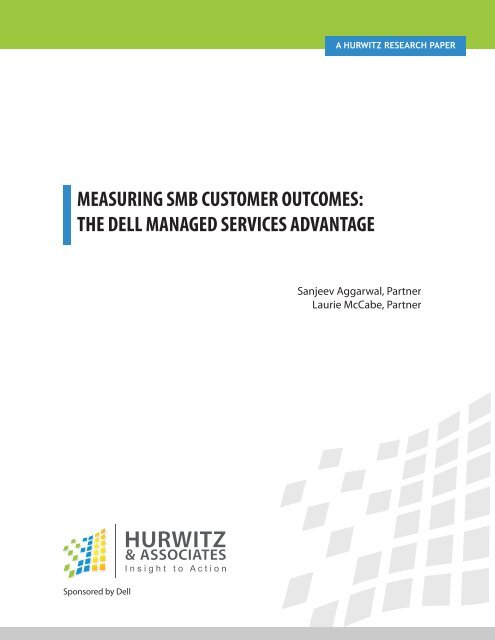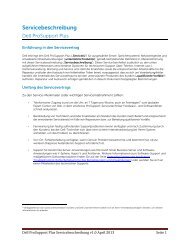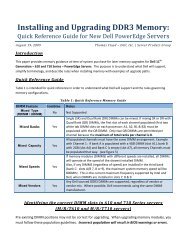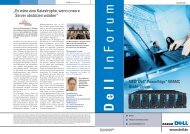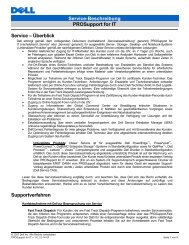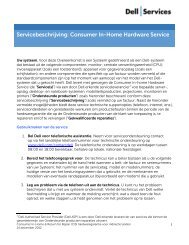Measuring SMB Customer Outcomes: The Dell Managed Services
Measuring SMB Customer Outcomes: The Dell Managed Services
Measuring SMB Customer Outcomes: The Dell Managed Services
Create successful ePaper yourself
Turn your PDF publications into a flip-book with our unique Google optimized e-Paper software.
MEASURING <strong>SMB</strong> CUSTOMER OUTCOMES:<br />
THE DELL MANAGED SERVICES ADVANTAGE<br />
Sponsored by <strong>Dell</strong><br />
A Hurwitz rESEArCH PAPEr<br />
Sanjeev Aggarwal, Partner<br />
Laurie McCabe, Partner
Page<br />
CONTENTS<br />
A Hurwitz rESEArCH PAPEr<br />
Introduction ....................................................................................................................................................................................................3<br />
Section 1: <strong>SMB</strong> Business and IT Challenges .........................................................................................................................................3<br />
Figure 1: Top Business Challenges for Businesses Adopting <strong>Dell</strong> <strong>Managed</strong> <strong>Services</strong> ...........................................................4<br />
Figure : Top IT Management Challenges for Businesses Adopting <strong>Dell</strong> <strong>Managed</strong> <strong>Services</strong> ............................................5<br />
Section : Key Drivers and Considerations for <strong>Managed</strong> <strong>Services</strong> ..............................................................................................5<br />
Figure 3: Key Drivers for <strong>SMB</strong> Consideration of <strong>Managed</strong> <strong>Services</strong> ............................................................................................6<br />
Figure 4: Resources for IT Infrastructure Management ...................................................................................................................7<br />
Figure 5: Key Concerns About <strong>Managed</strong> <strong>Services</strong> .............................................................................................................................8<br />
Section 3: Factors Leading <strong>SMB</strong> <strong>Customer</strong>s to Select <strong>Dell</strong> <strong>Managed</strong> <strong>Services</strong> ........................................................................8<br />
Figure 6: Top Factors Driving Adoption of <strong>Dell</strong> <strong>Managed</strong> <strong>Services</strong> .............................................................................................9<br />
Section 4: Before and After Comparison of IT Management Costs, Resource Requirements, and Productivity ..... 10<br />
Figure 7: Assessing Your Need for <strong>Managed</strong> <strong>Services</strong> ................................................................................................................... 10<br />
Figure 8: Direct and Indirect Benefits of Implementing <strong>Dell</strong> <strong>Managed</strong> <strong>Services</strong> ................................................................ 11<br />
Section 5: <strong>Customer</strong> Perceived Advantages and Satisfaction with <strong>Dell</strong> <strong>Managed</strong> <strong>Services</strong> ........................................... 11<br />
Figure 9: Key <strong>Customer</strong> Stated Advantages with <strong>Dell</strong> <strong>Managed</strong> <strong>Services</strong> ............................................................................. 1<br />
Figure 10: <strong>Customer</strong> Satisfaction Ratings for <strong>Dell</strong> <strong>Managed</strong> <strong>Services</strong> ..................................................................................... 13<br />
Section 6: Conclusions and Recommendations .............................................................................................................................. 14<br />
Figure 11: Guidelines for Evaluating <strong>Managed</strong> <strong>Services</strong> Providers and Offerings .............................................................. 14<br />
Appendix: Methodology and Demographics .................................................................................................................................. 15<br />
This is the second of two reports that highlight key findings from research with small and medium business (<strong>SMB</strong>)<br />
customers using <strong>Dell</strong> <strong>Managed</strong> <strong>Services</strong>; conducted by Hurwitz & Associates and sponsored by <strong>Dell</strong>. This second<br />
report is based on results from a detailed customer survey designed to gain a quantifiable view of the time, cost<br />
and productivity benefits that customers can achieve by using <strong>Dell</strong> <strong>Managed</strong> <strong>Services</strong>. <strong>The</strong> first report, “Solving the<br />
<strong>SMB</strong> IT Infrastructure Management Dilemma,” draws from in-depth qualitative customer discussions to examine<br />
business and technology drivers for managed services and the business benefits that customers gain with this<br />
approach. In tandem, the two studies provide small and medium business decision makers a better understanding<br />
of the benefits of managed services and how those benefits may be realized within their own organizations.<br />
<strong>Measuring</strong> <strong>SMB</strong> <strong>Customer</strong> <strong>Outcomes</strong>: <strong>The</strong> <strong>Dell</strong> <strong>Managed</strong> <strong>Services</strong> Advantage
Introduction<br />
Page 3<br />
A Hurwitz rESEArCH PAPEr<br />
<strong>SMB</strong>s are turning to managed service providers to help them monitor, manage, and maintain their increasingly<br />
important IT environments. By offloading routine yet vital IT infrastructure duties, these businesses hope to reduce<br />
IT operational costs and deliver higher service levels to the business. Just as importantly, they need to free up IT and<br />
business personnel to focus on more strategic business issues and less on day-to-day IT infrastructure management.<br />
But how well do managed services live up to the promise? In October 009, Hurwitz & Associates fielded an indepth<br />
survey of <strong>Dell</strong> <strong>Managed</strong> <strong>Services</strong> customers to gain a more detailed and quantifiable view of the time, cost,<br />
and productivity benefits that customers achieved from this offering. In this report, we provide survey results that<br />
highlight the business and IT demands that small and medium businesses face, and the reasons that decision-makers<br />
in these companies are adopting managed services. We also detail the cost, time and productivity benefits customers<br />
achieved by implementing <strong>Dell</strong> <strong>Managed</strong> <strong>Services</strong>.<br />
Prior to deploying <strong>Dell</strong> <strong>Managed</strong> <strong>Services</strong>, survey results indicate that <strong>SMB</strong> respondents were:<br />
•<br />
•<br />
•<br />
•<br />
Challenged to deploy new applications that address their business needs. 69% of respondents said their<br />
toughest IT challenge was to “implement new solutions that the business requires” to achieve business goals.<br />
Lacking the internal resources to provide the service levels and IT expertise that their businesses demand. In<br />
fact, 43% of respondents indicate that having a managed service provider that can manage their “complete IT<br />
infrastructure” is very important to them.<br />
Wanting to move internal IT staff to more strategic projects—not to reduce IT headcount. Only 3 % turn to<br />
managed services to “reduce internal IT staff.” In contrast, 71% of respondents view the ability to “free up internal<br />
IT staff to focus on core business instead of break/fix activities” as an important driver for managed services.<br />
Expressing concern about managed services pricing. 43% indicate that their perception that managed services<br />
was “too expensive for my budget” was a very important concern.<br />
Survey findings reveal that implementing <strong>Dell</strong> <strong>Managed</strong> <strong>Services</strong> has helped respondents reap significant benefits<br />
that aid in addressing these challenges, including:<br />
•<br />
•<br />
•<br />
•<br />
Realizing significant reductions in downtime. On average, annual downtime decreased by more than 50% after<br />
deploying the service. This translates into .5%-4.9% in revenue gains and decreased loss of revenues from<br />
inability to perform critical tasks due to a system outage.<br />
Helping companies focus and improve core business initiatives. Companies have reduced internal IT staff costs<br />
for IT infrastructure management by more than 50%. As a result, 89% of respondents say the service is “freeing<br />
up time so that they concentrate resources on more strategic business requirements.”<br />
An overwhelming 9 % of customers are achieving “better service” than with prior IT infrastructure management<br />
methods. 89% say the service is providing “improved service levels for key business applications.” By reducing<br />
downtime and the resulting inability to perform mission critical tasks, revenue loss from IT outages decreased by<br />
1.8%-3.5%.<br />
On average, <strong>SMB</strong> respondents are spending only . % to .6% of their annual revenues on <strong>Dell</strong> <strong>Managed</strong> <strong>Services</strong>.<br />
Actual managed service costs are very affordable, even for the smallest of companies.<br />
<strong>Measuring</strong> <strong>SMB</strong> <strong>Customer</strong> <strong>Outcomes</strong>: <strong>The</strong> <strong>Dell</strong> <strong>Managed</strong> <strong>Services</strong> Advantage
Section 1: <strong>SMB</strong> Business and IT Challenges<br />
Page 4<br />
A Hurwitz rESEArCH PAPEr<br />
In today’s demanding and competitive economic environment, businesses are more focused than ever on the<br />
bottom line. Survey respondents’ top concerns center on growing revenues, improving cash flow, attracting and<br />
retaining customers, and improving employee productivity (Figure 1).<br />
Figure 1: Top Business Challenges for Businesses Adopting <strong>Dell</strong> <strong>Managed</strong> <strong>Services</strong><br />
While <strong>SMB</strong>s view the right IT solutions and efficient IT operations as essential to overcoming these business<br />
challenges, most <strong>SMB</strong>s lack the resources, time, and budget that it takes to manage the increasingly complex IT<br />
environments underpinning their businesses.<br />
As we discuss in detail in the companion paper of this series, “Solving the <strong>SMB</strong> IT Infrastructure and Management<br />
Dilemma,” resource-constrained <strong>SMB</strong>s often struggle to take advantage of IT solutions that help them move the<br />
<strong>Measuring</strong> <strong>SMB</strong> <strong>Customer</strong> <strong>Outcomes</strong>: <strong>The</strong> <strong>Dell</strong> <strong>Managed</strong> <strong>Services</strong> Advantage
Page 5<br />
A Hurwitz rESEArCH PAPEr<br />
business forward. Survey results underscore this problem. As shown in Figure 2, 69% of respondents indicate that<br />
their most difficult IT management related challenge is “implementing new solutions that the business requires.”<br />
Figure 2: Top IT Management Challenges for Businesses Adopting <strong>Dell</strong> <strong>Managed</strong> <strong>Services</strong><br />
<strong>The</strong> response is not surprising considering that almost half of the respondents are also worrying about keeping their<br />
existing infrastructure running smoothly and doing it all on a tight budget. For many <strong>SMB</strong>s, daily management chores<br />
associated with keeping the IT environment stable leave little time to address more strategic IT initiatives.<br />
Section 2: Key Drivers and Considerations for <strong>Managed</strong> <strong>Services</strong><br />
Faced with challenges and constraints, <strong>SMB</strong>s often seek external providers to help them manage and run their IT<br />
infrastructure. As indicated in Figure 3, the top reason respondents turn to managed services is to provide “more<br />
proactive services and improved service levels.” In fact, 86% listed this as either a very or somewhat important reason<br />
for their interest in managed services. This dovetails with a majority of respondents citing the “inability of internal staff<br />
<strong>Measuring</strong> <strong>SMB</strong> <strong>Customer</strong> <strong>Outcomes</strong>: <strong>The</strong> <strong>Dell</strong> <strong>Managed</strong> <strong>Services</strong> Advantage
Figure 3: Key Drivers for <strong>SMB</strong> Consideration of <strong>Managed</strong> <strong>Services</strong><br />
Page 6<br />
A Hurwitz rESEArCH PAPEr<br />
to manage an increasingly complex and/or heterogeneous IT infrastructure environment” and the desire to “reduce<br />
downtime” as key drivers for managed services as very or somewhat important.<br />
Notably, while some respondents turn to managed service providers to augment internal IT infrastructure<br />
management resources, a significant percentage has a keen interest in a service provider taking all IT infrastructure<br />
management and monitoring chores off their plates. 43% of respondents indicate that having a managed services<br />
provider manage their “complete IT infrastructure—servers, storage, desktops/laptops, network and security” is very<br />
important. This isn’t surprising given the fact that the majority of survey respondents have one or fewer full-time IT<br />
personnel, which they augment with part-time internal IT resources and external service providers (Figure 4).<br />
Once they offload some or all of these chores, <strong>SMB</strong>s intend to refocus internal IT personnel on more strategic projects.<br />
71% of respondents are “very interested” or “somewhat interested” in contracting with a managed services provider<br />
to “free up IT staff to focus on core business instead of break/fix activities.” With mundane IT chores under control,<br />
internal IT staff can focus on helping the business deploy the new applications that it needs to grow. Contrary to<br />
<strong>Measuring</strong> <strong>SMB</strong> <strong>Customer</strong> <strong>Outcomes</strong>: <strong>The</strong> <strong>Dell</strong> <strong>Managed</strong> <strong>Services</strong> Advantage
Figure 4: Resources for IT Infrastructure Management<br />
Page 7<br />
A Hurwitz rESEArCH PAPEr<br />
popular opinion, most are not looking to reduce internal IT headcount. Only 7% of respondents cite the “need to<br />
reduce internal IT staff to cut costs” as very important in their company’s decision to adopt managed services.<br />
While <strong>SMB</strong>s recognize the benefits that managed services can provide, concerns linger regarding the ability of<br />
providers to meet their expectations and requirements. As shown on Figure 5, when asked to rate the importance<br />
of several issues that they have when considering managed services, respondents put “timeliness of response” at the<br />
top of the list, with 96% rating this as very or somewhat important. 75% rank “information security concerns” as very<br />
or somewhat important, and 64% of respondents indicate that a service provider’s ability to “provide on-site support<br />
if needed” is very or somewhat important. As discussed in ”Solving the <strong>SMB</strong> IT Infrastructure and Management<br />
Dilemma,” these concerns may stem from past experiences with managed service providers who failed to deliver on<br />
the <strong>SMB</strong>s’ service expectations.<br />
Respondents also expressed a high degree of concern about managed services pricing. 43% indicate “too expensive<br />
for my budget” as a very important concern, and 61% say that concerns about “complex pricing models” were very or<br />
somewhat important factors impacting managed services decisions. <strong>The</strong>se concerns mirror the reality that managed<br />
<strong>Measuring</strong> <strong>SMB</strong> <strong>Customer</strong> <strong>Outcomes</strong>: <strong>The</strong> <strong>Dell</strong> <strong>Managed</strong> <strong>Services</strong> Advantage
Figure 5: Key Concerns About <strong>Managed</strong> <strong>Services</strong><br />
Page 8<br />
A Hurwitz rESEArCH PAPEr<br />
services providers have too frequently not provided the services that <strong>SMB</strong>s need at prices they can afford. In other<br />
cases, pricing isn’t readily available on vendors’ web sites, or pricing schemes may be too convoluted for timestretched<br />
<strong>SMB</strong>s to decipher.<br />
“Loss of control and visibility into IT operations” and “resistance from internal IT staff” appear to be non-issues for most<br />
respondents. Only 14% and 11% of respondents respectively rate these issues as very important.<br />
Section 3: Factors Leading <strong>SMB</strong> <strong>Customer</strong>s to Select <strong>Dell</strong> <strong>Managed</strong> <strong>Services</strong><br />
Drivers and considerations for managed services map quite closely to the reasons that respondents selected <strong>Dell</strong><br />
<strong>Managed</strong> <strong>Services</strong>, as illustrated on Figure 6. A substantial majority chose <strong>Dell</strong> because of their belief that <strong>Dell</strong> can<br />
provide reliable, responsive and proactive service:<br />
<strong>Measuring</strong> <strong>SMB</strong> <strong>Customer</strong> <strong>Outcomes</strong>: <strong>The</strong> <strong>Dell</strong> <strong>Managed</strong> <strong>Services</strong> Advantage
Figure 6: Top Factors Driving Adoption of <strong>Dell</strong> <strong>Managed</strong> <strong>Services</strong><br />
•<br />
•<br />
•<br />
Page 9<br />
79% indicated that <strong>Dell</strong>’s ability to provide “service reliability” was very important.<br />
A Hurwitz rESEArCH PAPEr<br />
71% rated both “responsiveness—one call to a designated person for support” and “proactive vs. reactive<br />
support” as very important in their decisions to go with <strong>Dell</strong>.<br />
61% felt it was very important that <strong>Dell</strong> could provide most of its services remotely, but provide on-site support<br />
when necessary.<br />
Pricing and ease of doing business also played a positive role in respondents’ decisions to choose <strong>Dell</strong>. 89% of<br />
respondents rated “pricing of services—cost effective at a fixed monthly price” as very or somewhat important, while<br />
8 % ranked contract flexibility as very or somewhat important.<br />
<strong>Measuring</strong> <strong>SMB</strong> <strong>Customer</strong> <strong>Outcomes</strong>: <strong>The</strong> <strong>Dell</strong> <strong>Managed</strong> <strong>Services</strong> Advantage
Page 10<br />
A Hurwitz rESEArCH PAPEr<br />
Section 4: Before and After Comparison of IT Management Costs, Resource Requirements, and Productivity<br />
Costs for <strong>Dell</strong> <strong>Managed</strong> <strong>Services</strong> tend to correlate with company size and the number of IT assets being managed.<br />
96% of respondents surveyed chose <strong>Dell</strong>’s most comprehensive service which includes alerts, monitoring, and<br />
management. As indicated on Figure 7, companies are spending approximately . % to .6% of their annual revenues<br />
on <strong>Dell</strong> <strong>Managed</strong> <strong>Services</strong>, putting it in a very affordable price range for even the smallest of companies.<br />
Figure 7: Assessing Your Need for <strong>Managed</strong> <strong>Services</strong><br />
We asked respondents to provide spending, resource, and IT infrastructure outage related metrics for their IT<br />
environment before and after deploying <strong>Dell</strong> <strong>Managed</strong> <strong>Services</strong>. As illustrated in Figure 8, we found that on average,<br />
<strong>Dell</strong> <strong>Managed</strong> <strong>Services</strong> customers realized significant advantages in terms of direct cost savings and indirect business<br />
benefits from deploying <strong>Dell</strong> <strong>Managed</strong> <strong>Services</strong>. <strong>The</strong>se benefits were consistent even though company size (number<br />
of employees and revenues), IT infrastructure, complexity, and staffing varied across respondents.<br />
<strong>The</strong> key direct benefits that companies realized after implementing <strong>Dell</strong> <strong>Managed</strong> <strong>Services</strong> include reducing internal<br />
IT staff-related costs for IT infrastructure management by more than 50%. Respondents were able to reduce this cost<br />
from approximately 1. -1.5% of annual revenues (before <strong>Dell</strong> <strong>Managed</strong> <strong>Services</strong>) to about 0.5% to 1.1% of revenues<br />
(after implementing <strong>Dell</strong> <strong>Managed</strong> <strong>Services</strong>). <strong>Dell</strong> <strong>Managed</strong> <strong>Services</strong> has enabled companies to reallocate both<br />
internal IT staff and VAR resources from routine maintenance to higher value-add areas for their businesses.<br />
<strong>Measuring</strong> <strong>SMB</strong> <strong>Customer</strong> <strong>Outcomes</strong>: <strong>The</strong> <strong>Dell</strong> <strong>Managed</strong> <strong>Services</strong> Advantage
Figure 8: Direct and Indirect Benefits of Implementing <strong>Dell</strong> <strong>Managed</strong> <strong>Services</strong><br />
Page 11<br />
A Hurwitz rESEArCH PAPEr<br />
Companies also achieved important indirect benefits after implementing <strong>Dell</strong> <strong>Managed</strong> <strong>Services</strong>, such as:<br />
•<br />
•<br />
Reducing lost productivity related to planned and unplanned IT infrastructure downtime from approximately<br />
190 hours to 34 hours per year, per employee. <strong>The</strong> proactive service focus of <strong>Dell</strong> <strong>Managed</strong> <strong>Services</strong> significantly<br />
reduced both planned and unplanned IT infrastructure outages. As a result, <strong>Dell</strong> <strong>Managed</strong> <strong>Services</strong> customers<br />
reduced annual productivity loss from unplanned IT downtime by approximately 0.7% to 1.4% of revenue after<br />
implementing the service.<br />
Lessening the impact on company revenues due to downtime and resulting inability to perform mission critical<br />
tasks, such as access to business applications and ecommerce systems. After implementing <strong>Dell</strong> <strong>Managed</strong><br />
<strong>Services</strong>, respondents realized a significant reduction in IT related outages. In turn, revenue loss from IT<br />
downtime decreased by 1.8%-3.5% of revenue.<br />
Section 5: <strong>Customer</strong> Perceived Advantages and Satisfaction with <strong>Dell</strong> <strong>Managed</strong> <strong>Services</strong><br />
In addition to the quantifiable benefits discussed in Section 4, customers using <strong>Dell</strong> <strong>Managed</strong> <strong>Services</strong> highlight<br />
other more qualitative yet important advantages they’ve gained. Among the top four benefits cited, three relate<br />
directly to having better, more reliable, more responsive service, and problem resolution. As shown on Figure 9,<br />
an overwhelming 9 % agree or somewhat agree that <strong>Dell</strong>’s “better service—experienced staff, quick resolution,<br />
<strong>Measuring</strong> <strong>SMB</strong> <strong>Customer</strong> <strong>Outcomes</strong>: <strong>The</strong> <strong>Dell</strong> <strong>Managed</strong> <strong>Services</strong> Advantage
Figure 9: Key <strong>Customer</strong> Stated Advantages with <strong>Dell</strong> <strong>Managed</strong> <strong>Services</strong><br />
Page 1<br />
A Hurwitz rESEArCH PAPEr<br />
responsiveness, and reporting” are the top advantage, while 85% said that <strong>Dell</strong> “provides faster problem resolution<br />
than I had in the past,” and 79% agree or somewhat agree that <strong>Dell</strong> has “reduced unplanned IT downtime.”<br />
Furthermore, a vast majority of <strong>Dell</strong> <strong>Managed</strong> <strong>Services</strong> customers are using the service to realize the critically<br />
important goal of refocusing internal IT staff on core, strategic business requirements and utilize those resources more<br />
effectively for the benefit of the organization:<br />
•<br />
•<br />
•<br />
•<br />
89% agree or somewhat agree that the service “enables my organization to focus more time and resources on its<br />
core business.”<br />
89% agree or somewhat agree that the service “provides improved service levels for key business applications.”<br />
8 % agree or somewhat agree that <strong>Dell</strong> <strong>Managed</strong> <strong>Services</strong> has “enabled their organization to deal with more<br />
sophisticated IT requirements.”<br />
71% agree or somewhat agree that the service has “enabled IT to better meet business requirements.”<br />
<strong>Measuring</strong> <strong>SMB</strong> <strong>Customer</strong> <strong>Outcomes</strong>: <strong>The</strong> <strong>Dell</strong> <strong>Managed</strong> <strong>Services</strong> Advantage
Page 13<br />
A Hurwitz rESEArCH PAPEr<br />
<strong>Customer</strong> satisfaction ratings are quite high, especially for this recently introduced service (<strong>Dell</strong> began the initial<br />
launch in February, 009, with full U.S. coverage slated for April 010) . As shown in Figure 10, customers give <strong>Dell</strong><br />
<strong>Managed</strong> <strong>Services</strong> the highest grades in the areas of responsiveness, technical competence, service reliability, and<br />
portfolio of IT infrastructure services. In almost every area, a majority of respondents are either very satisfied or<br />
satisfied with the service.<br />
Figure 10: <strong>Customer</strong> Satisfaction Ratings for <strong>Dell</strong> <strong>Managed</strong> <strong>Services</strong><br />
<strong>The</strong>re are a few areas in which a relatively small percentage of respondents indicate that <strong>Dell</strong> services could be<br />
improved. In particular, 11% are dissatisfied or very dissatisfied with “managaement capabilities and tools,” pointing<br />
to a need for <strong>Dell</strong> to improve this component of the service. Although the vast majority is happy with <strong>Dell</strong>’s “portfolio<br />
of IT infrastructure services,” 7% are dissatisfied or very dissatisfied with this area, indicating a belief that <strong>Dell</strong> should<br />
add additional services. In addition, <strong>Dell</strong> may want to improve availability of the service via local VARs and consultant<br />
channels for customers that prefer to work with local providers.<br />
<strong>Measuring</strong> <strong>SMB</strong> <strong>Customer</strong> <strong>Outcomes</strong>: <strong>The</strong> <strong>Dell</strong> <strong>Managed</strong> <strong>Services</strong> Advantage
Section 6: Conclusions and Recommendations<br />
Figure 11: Guidelines for Evaluating <strong>Managed</strong> <strong>Services</strong> Providers and Offerings<br />
Page 14<br />
A Hurwitz rESEArCH PAPEr<br />
As detailed in the companion paper, “Solving the <strong>SMB</strong> IT Infrastructure Management Dilemma,” each company must<br />
evaluate their need for managed IT services by assessing their own requirements and capabilities. After completing<br />
this assessment, it is likely that many <strong>SMB</strong>s will identify IT infrastructure inefficiencies, gaps, and points of pain that<br />
result in productivity and revenue losses, opening the door to increased business risk.<br />
Given these circumstances, more <strong>SMB</strong>s will turn to managed services providers for help. In doing so, <strong>SMB</strong>s should<br />
thoroughly evaluate the abundant managed service provider offerings to find solutions that are a proper fit for their<br />
needs and budgets, while being backed up with experienced, proactive around-the-clock service teams.<br />
Judging from the results of this survey, as well as detailed one-on-one interviews performed for “Solving the <strong>SMB</strong><br />
IT Infrastructure Management Dilemma,” we believe <strong>Dell</strong> is providing a very strong mix of these capabilities with<br />
<strong>Dell</strong> <strong>Managed</strong> <strong>Services</strong>. <strong>Dell</strong>’s proactive managed services offering and comprehensive focus on the <strong>SMB</strong> market<br />
(including hardware, solutions and services) differentiate <strong>Dell</strong> in the market. In addition, <strong>Dell</strong> has the capability to<br />
provide consistent support to companies that have multiple locations. While no one vendor can be a best fit for all<br />
<strong>SMB</strong> needs, based upon these respondents’ high level of satisfaction, it is clear that <strong>Dell</strong> <strong>Managed</strong> <strong>Services</strong> should be<br />
on the short list for serious consideration.<br />
We recommend using the guidelines in Figure 11 when evaluating and selecting managed services provider.<br />
Key Criteria Questions for Vendors<br />
Initial assessment and<br />
implementation<br />
Experience with<br />
hardware and<br />
software environment<br />
Flexibility and<br />
scalability<br />
•<br />
•<br />
•<br />
•<br />
•<br />
•<br />
•<br />
•<br />
•<br />
What is the process to assess and correct the existing environment?<br />
Does the vendor have tools and methodology to streamline this?<br />
What is done remotely, and what (if anything) is done on-site?<br />
How long will it take?<br />
What type of expertise and depth of experience does the vendor have to identify and<br />
resolve problems on the critical systems in my environment?<br />
Does the vendor have experience managing heterogeneous systems environments?<br />
Do they have any experience with business applications?<br />
Can you buy just the services you want, and add additional ones as needed?<br />
Does the vendor have the personnel and infrastructure to easily absorb increased service<br />
requirements?<br />
Pricing • What does the pricing cover? What doesn’t it cover?<br />
• Are there different types of subscription plans (for example monthly/annual contracts,<br />
premium services)?<br />
• Do I need to plan for cost overruns if the vendor needs to spend additional time to identify<br />
and/or fix a problem?<br />
Reporting and<br />
visibility<br />
Account resources<br />
and responsiveness<br />
•<br />
•<br />
•<br />
•<br />
•<br />
•<br />
•<br />
What kind of visibility do I have into the services provided?<br />
What types of reports does the vendor provide? How often?<br />
Can the vendor customize the information or frequency of these reports for my needs?<br />
Can the vendor provide me with a consistent team, or is service disjointed?<br />
Does the vendor have the personnel and infrastructure to respond to my concerns and keep<br />
me informed?<br />
Does the vendor provide 4/7 service, 365 days/year?<br />
What service and response levels does the vendor guarantee?<br />
<strong>Measuring</strong> <strong>SMB</strong> <strong>Customer</strong> <strong>Outcomes</strong>: <strong>The</strong> <strong>Dell</strong> <strong>Managed</strong> <strong>Services</strong> Advantage
Appendix: Methodology and Demographics<br />
Page 15<br />
A Hurwitz rESEArCH PAPEr<br />
<strong>The</strong> <strong>Dell</strong> <strong>Managed</strong> <strong>Services</strong> survey was conducted by Hurwitz and Associates in September and October 009. Webbased<br />
survey respondents included 9 business and information technology decision-makers at small and medium<br />
sized businesses (firms with 5-500 employees). <strong>The</strong> survey was conducted in the United States and United Kingdom,<br />
and respondents represented a cross-section of industries and non-profits.<br />
<strong>The</strong> quantitative benefits methodology used in this study is based on respondents’ answers to questions asking them<br />
to compare their IT experiences “before and after” deploying <strong>Dell</strong> <strong>Managed</strong> <strong>Services</strong>. We examined this comparison in<br />
areas including IT budgets, internal and external IT resources, number of outages, length of outages, and number of<br />
people affected by outages.<br />
“Before and after” calculations were determined by asking respondents for details about the total number of internal<br />
and external IT resources deployed to manage their IT infrastructure and the average monthly and/or hourly costs<br />
of these resources. This data provided a direct comparison of IT infrastructure management costs before and after<br />
deploying <strong>Dell</strong> <strong>Managed</strong> <strong>Services</strong>.<br />
Indirect benefits were determined by asking respondents to provide information about IT related outages that they<br />
experienced on a weekly basis, and the number of people affected by these outages. In addition, respondents were<br />
asked to provide data points on their annual revenues and number of employees. From this data, we calculated<br />
average annual revenue per employee, lost productivity due to outages, and the average cost of annual downtime to<br />
the business.<br />
Due to the variety of respondents in term of company size, industry and technical sophistication, we established a<br />
range to more accurately reflect the cost, productivity and impact on annual revenues before and after deploying <strong>Dell</strong><br />
<strong>Managed</strong> <strong>Services</strong>.<br />
<strong>Measuring</strong> <strong>SMB</strong> <strong>Customer</strong> <strong>Outcomes</strong>: <strong>The</strong> <strong>Dell</strong> <strong>Managed</strong> <strong>Services</strong> Advantage
About Hurwitz & Associates<br />
Hurwitz & Associates is a consulting, market research and analyst firm that focuses on how technology<br />
solutions solve real world business problems. <strong>The</strong> firm’s research concentrates on disruptive technologies,<br />
such as Cloud Computing, Service Oriented Architecture and Web .0, Service Management, Information<br />
Management, and Social and Collaborative Computing. We help our customers understand how these<br />
technologies are reshaping the market and how they can apply them to meet business objectives. <strong>The</strong> team<br />
provides direct customer research, competitive analysis, actionable strategic advice, and thought leadership.<br />
Additional information on Hurwitz & Associates can be found at www. hurwitz.com.<br />
© Copyright 010, Hurwitz & Associates<br />
All rights reserved. No part of this publication may be reproduced or stored in a retrieval system or<br />
transmitted in any form or by any means, without the prior written permission of the copyright holder.<br />
Hurwitz & Associates is the sole copyright owner of this publication. All trademarks herein are the property of<br />
their respective owners.<br />
33 Needham Street • Newton, MA 0 464 • Tel: 617 454 1030<br />
w w w . h u r w i t z . c o m


